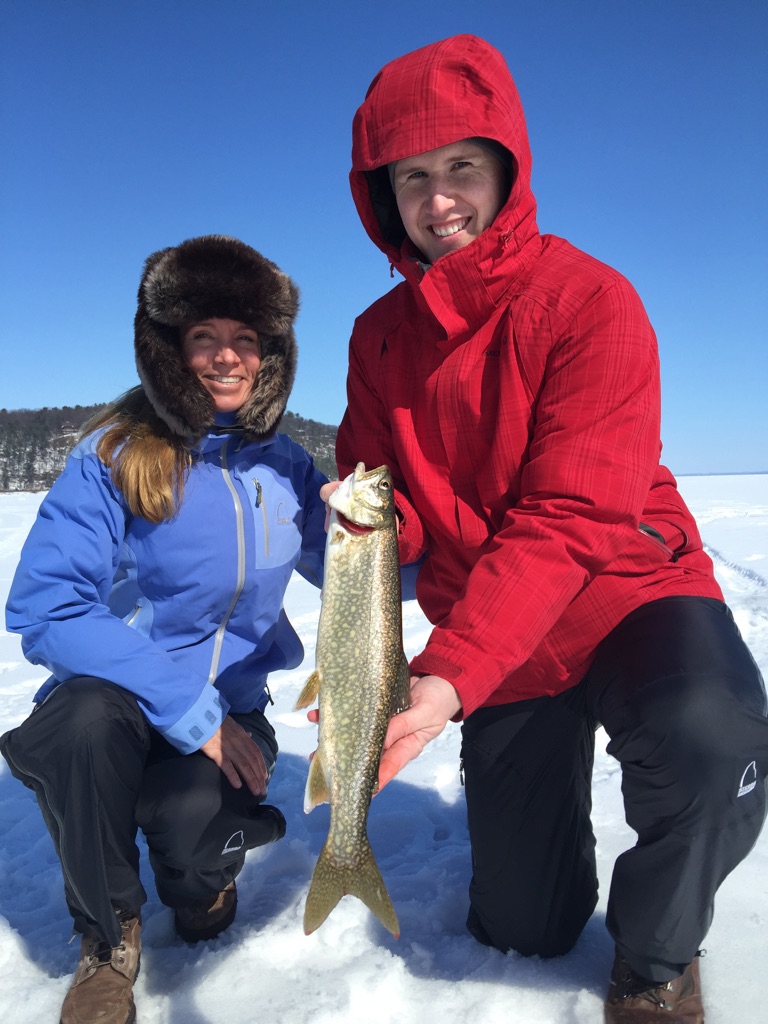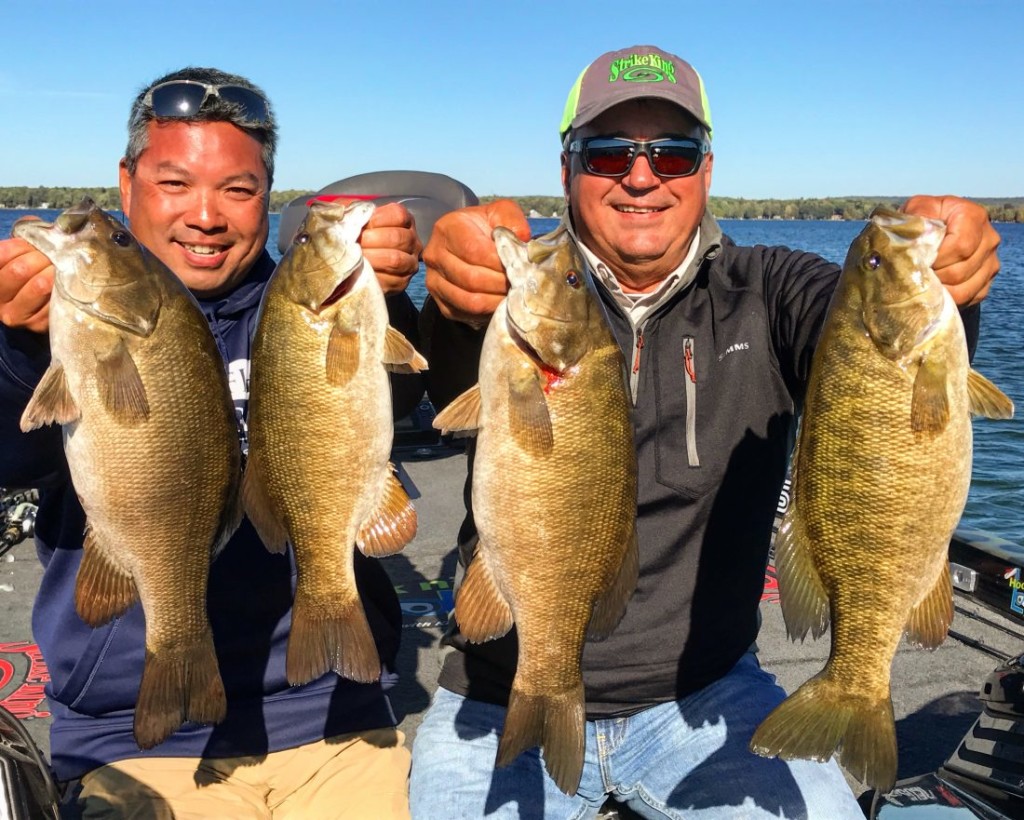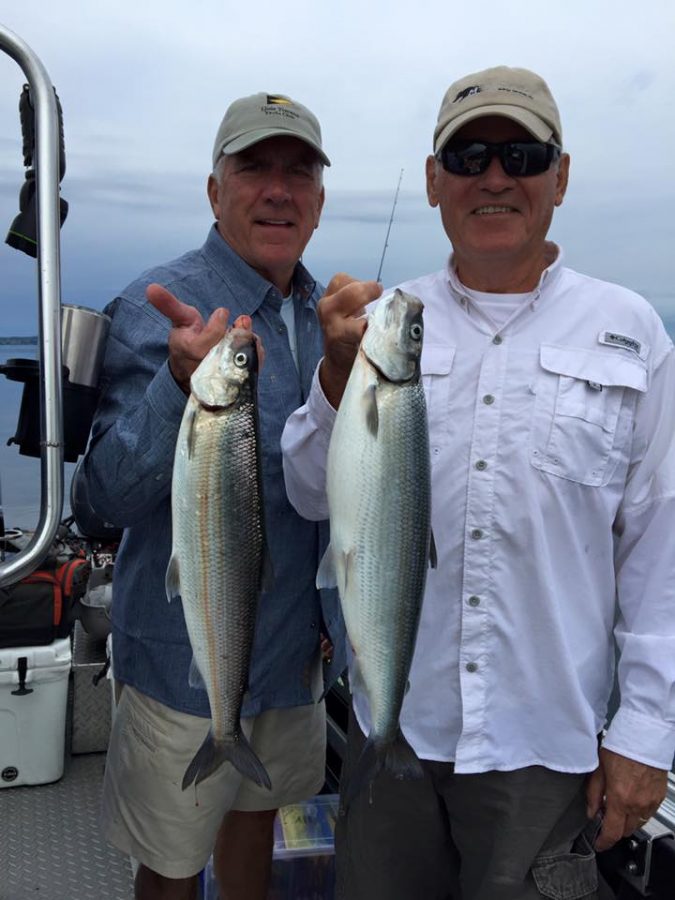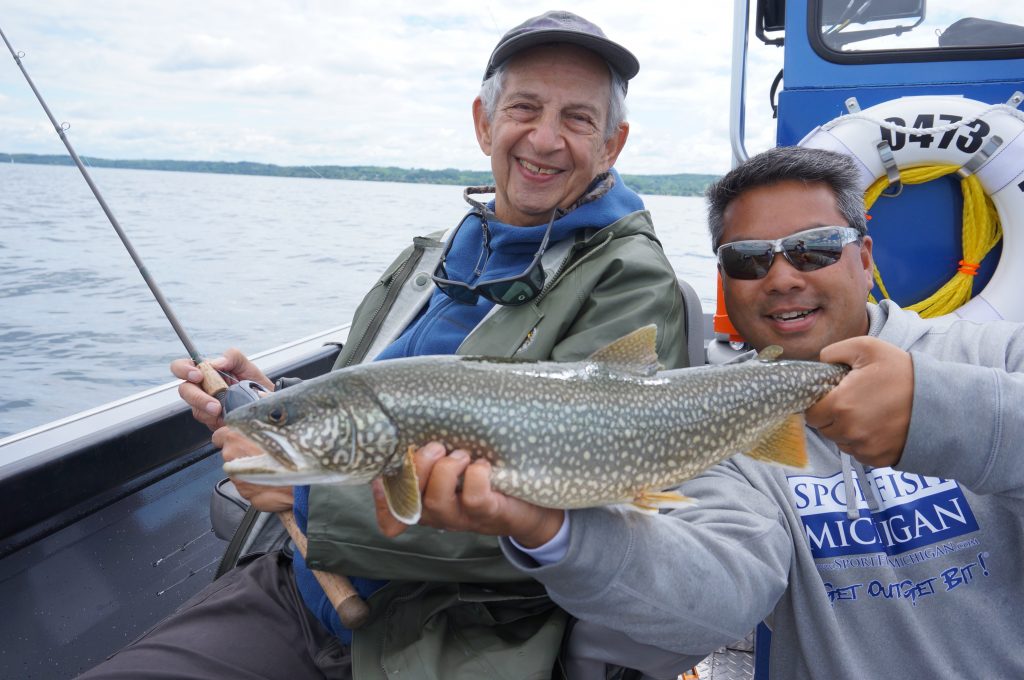Captain Ben Wolfe of Sport Fish Michigan – AnglingBuzzTV fishing report for early May in Michigan. Walleye fishing – Detroit River, smallmouth bass at Lake St. Clair, cisco on Grand Traverse Bays, and fishing tips.
Tag Archives: cisco
Sport Fish Michigan Fishing Report 04.01.17
The fishing in Northern Michigan is on fire right now! Our area is producing some excellent numbers of fish, both in the rivers systems and on open water. We are so grateful to have such awesome fishing and wonderful clients. Here is a sneak peak at what we have been up to:
Inland lakes and Grand Traverse Bay have been producing good catches of perch. Most fish in GTB have been found in 50-70ft. of water. We have seen schools even as deep as 90+ ft., as well. Larger schools are consisting of 7-9-inch fish, but when you can find the smaller concentrations, you can locate the larger fish. Good electronics, such as a Humminbird Helix unit, are crucial in finding these schools. We are so excited to see the perch populations returning to GTB and surrounding ports. Inland lake perch fishing has been good adjacent to drop-offs and weed covered flats in 25-55ft., depending on the bottom make-up. Perch minnows and wigglers have been working well. Finding a softer bottom has been key.
GTB has been producing limits of lake trout and cisco. Locating fish has not been difficult at all, finding hungry, active fish has, and can be, a bit of challenge. Fish in deeper water have been more aggressive than the shallower schools. 100-135ft. seems to have large concentrations, but the more active fish have been found feeding in 145-160ft. The trout are gathering in the bottom 10 feet, and the cisco seem to be behaving as they always do in 35-degree water. Cisco can be found feeding aimlessly, with no patterned depth in the water column. A simple mark and drop technique has been working well when jigging and casting for these fish in deeper water. Cisco in the spring often feed half-way up in the water column, and seeing marks “zooming” across our Humminbird Helix screens is the tell-tale regarding the depth in which these scrappy fish are feeding.
Trolling the shallow water on the shores of Lake Michigan out of ports like Frankfort, Manistee, Arcadia, and Onekama for brown trout has been great. Using lighter fluorocarbon and longer leads on inline planer boards has worked well. We have found that using more natural colors in clearer water, and brighter colors in dirtier water, has been producing more biters. Most temperatures have been from 36-38 degrees, if you can find any pockets of water with 40-41 degree temps, you should find browns.
Fishing on the rivers, we have seen one of the best runs of steelhead our area tributaries have had in quite a few years. We have consistently been hitting fresh fish for the past three months. Just when we think that the run has peaked, and the fish are slowing down, we get another inch of rain and more fish come into the Lake Michigan tributary systems!
This past week’s warmer temperatures, however, have increased temps to the low 40’s, and this is really initiating the spawning process. A lot of active, hungry fish have been coming in the faster tail-out water of spawning gravel. Depending on the river, 3-5ft of water has been good. Finding the slower seams in the bottom, inside and outside of faster water covering the spawning gravel has been best. Steelhead seem to have now left the slower, sandier, wintering holes, working their way to higher, faster sections of water.
Trout beads, stoneflies, and hare’s ear flies have been great with both fly rod and conventional gear. Indicator fishing and float fishing with beads and spawn has been most productive. We have found that even with the dirtier water, 8mm beads have produced the most fish. Colors like Sun Orange have definitely been the MVP of the spring, with the Clown egg in a close second.
While anglers with a valid fishing license are certainly allowed to keep their limit of steelhead, we at Sport Fish Michigan like to practice catch and release whenever we can. Many of these fish can successfully spawn, and are not reliant on stocking programs. For this reason, releasing spawning fish is crucial in helping to maintain our steelhead fisheries for years to come.
Good luck out there, we hope to see you on the water!
Sport Fish Michigan Lake Report March – April 2017
Spring is here! With all the ice gradually melting, open water fishing on most inland lakes is in full swing and Grand Traverse Bay is open for some great fishing opportunities, as well. Listed below is brief description of what techniques and tips Sport Fish Michigan has to offer anglers when hitting the water over the course of the next month.
Inland lake fishing for perch has been very good, and this is an awesome time of year to take advantage of big fish and large schools. Most fish can be found feeding in 38-50 feet of water adjacent to steeper drop-offs and weed-covered flats. If you are lucky enough to find perch minnows at your local bait shop, this will help yield the best action when targeting perch. The fish tend to move this time of year as they are actively spawning and transitioning from deeper to shallower water. Make sure to use a Minn Kota Motors I-Pilot or back trolling technique, as using an anchor can spook the school, forcing them to move.
Grand Traverse Bay has been fishing very well this March and will only continue to heat up for several species. Lake trout and cisco fishing is incredible this time of year. Utilizing good, effective electronics, and successfully anchoring on top of large schools will bring the most success. This time of the year, jigging spoons and blade baits are key, fish are constantly moving, in search for alewife, gobies, and other baitfish in the warming water. 50-100 feet of water is a great place to start, this is usually a key area to find both species, however don’t be afraid to check shallower as the water warms, as most of the baitfish and insect life will be gathering around the warmer rocks and weed cover. And if all else fails, deep waters of 150 feet or even more will almost always hold fish. These deeper fish may not be the actively feeding fish that cruise the shallower waters, but can often be tempted with a good jig.
Traverse City, Frankfort, Leland, and Manistee offer some excellent shallow water trolling opportunities on Lake Michigan for brown trout, steelhead, and even the occasional lake trout. Anglers will have great success trolling body baits on in-line planer boards in 8-15 feet of water. Locating stained water areas and gradual temperature breaks will help pinpoint where feeding fish are located. Browns tend to congregate in the water that has the least amount of visibility and the warmest temperature. Don’t be afraid to fish very close to the shoreline, the inside trough can be very productive this time of year!
Good luck and see you on the water!
Sport Fish Michigan March 2017 Angler Magazine Report
With there still ice fishing to be done on many inland lakes, the annual spring steelhead run into the area’s Lake Michigan tributary rivers, as well as the open water bite for species like cisco, lake trout, burbot, brown trout and lots more, the opportunities abound for anglers here in Northern Michigan.
The river fishing for steelhead pushing into the area’s rivers should be excellent if this fall’s run is any indication. While many fish held over the winter in the rivers, there should be a few nice pushes of fresh fish to target. Jigs tipped with wax worms fished under a float should tempt these frigid water chrome battlers if a spawn bag doesn’t do the trick. For fly anglers, egg patterns, leech patterns or small minnow patterns will all work.
For anglers looking to get that last ice bite, the perch and the walleyes are feeding more these days with their upcoming annual spawn. Both of these species will spawn in the early spring, shortly after ice-out, and much of their pre-spawn bite window takes place under the ice. Jigging Rapalas or jigging spoons tipped with a minnow head can be deadly for cruising walleye both early or late in the day. For perch anglers, minnows can often attract hungry jumbos, but sometimes downsizing to a small tungsten jig tipped with a spike or a wax worm will seal the deal. But anglers should keep in mind that as ice thaws, extra caution should be taken when venturing out. No matter how good the late ice bite can be, no fish is worth having an accident over.
Ciscos, burbot, lake trout and whitefish all bite well during the cold water periods of March. Trolling is an excellent way to cover water, and vertical jigging is a fantastic way to stay over top of a school of fish. Trolling spoons, plugs or even vibrating blade baits can be the ticket to getting the Ciscos, lake trout and whitefish to bite. For jigging options, spoons and blade baits are the way to go. Look for schools or marks adjacent to steep breaks or depth contours like inside turns or points or humps.
We here at Sport Fish Michigan are looking forward to getting back onto the water after a busy ice guiding season. While there are still ice trips to be run yet, we are anxious to get after the early ice-out fishing that can often times be dynamite. Get out and have a great time fishing, whether it’s on the last of our ice or in a boat. Take lots of care, however, since the waters are still ice cold. No matter which body of water you fish, know what technique is most enjoyable to you, have fun, stay safe, and catch some fish!
Sport Fish Michigan November 2016 Angler Magazine Report
Northwest Michigan Area Fishing Report
As the waters cool, opportunities still abound for some spectacular fall fishing. While many are taking to the woods for the fall hunting season, anglers willing to brave the chillier weather can be rewarded for almost every species.
For inland lakes, walleyes, yellow perch, and smallmouth bass are prime targets as they put on the feedbag for winter. With the shorter days, the feeding windows are condensed, giving anglers some great chances to intercept the active fish. For walleyes, pulling minnow plugs behind planer boards adjacent to steep break lines remains a great option right at dusk. Anglers wanting to cast shouldn’t overlook the mid-day feeding window with baits like a leadhead jig tipped with a paddle tail soft plastic. Perch anglers can score big with nice jumbos using perch rigs tipped with wigglers or even small perch flies tipped with a small piece of cocktail shrimp. Another favorite option that can really call in some nicer fish is a small jigging spoon with a dropper chain. For some reason, big jumbo perch really like the action of a jigging spoon and will sometimes take this offering when few other things seem to be working.
Inland lake bass fishing can be incredible, and the fish on the inland lakes come up to the shallow flats to feed before heading deep for winter. Swimbaits, crankbaits, and even spinnerbaits are all great options to throw this time of year. Don’t be afraid to try skinny water at times if there is sunny weather. It’s not uncommon for smallmouths to roam into water as shallow as four feet or so during the fall feed. This is a time of year when bronzebacks famously “wolf pack”, and locating one in an area generally means that there are many more around.
Grand Traverse Bay Fishing Report
Fall bass fishing in Northern Michigan can be just as good as the spring pre-spawn fishing, but with lots less angling pressure. True, the fall gales can be an issue when planning a trip, but when we have the weather, the fishing can be awesome!
The Grand Traverse Bays cool much slower than the inland lakes, meaning that the fish are down in deeper water later into the year, and deep water tactics are the way to go here. Very often, fishing the steep breaks are the way to locate smallmouths as they will venture up onto the breaks to feed, retreating down deep during periods of inactivity. Drop shot techniques, swimbaits and crankbaits are great fall options and are some of the go-to options for Traverse City Bass Guide Service and Sport Fish Michigan.
For anglers looking to put some meat into a cooler on the Bays, yellow perch schools are roaming around in huge numbers not seen in years! While many of these schools have 4-6 inch perch, there are some bigger fish around. What is exciting is to see the number of smaller fish, meaning that we should have some outstanding jumbo perch fishing in the years to come if we are careful about not overharvesting this fantastic and tasty fish.
Another stellar option is the cisco aka lake herring. With a change in diets over the past several years, they are incredibly good table fare now, and are now exciting more and more anglers. They are extremely plentiful in Grand Traverse Bays, and are super aggressive feeders as well, hitting seemingly anything that comes close to them. Jigging spoons in a 1 ounce or 1-1/2 ounce size are perfect for these fish, as are blade baits. Ciscos these days are running much larger than they ever have, and 4 pound plus fish are common on guide trips this past year for Sport Fish Michigan. Trolling is another productive way to target these fish, but smaller hooks may be the ticket to a higher landing ratio. Cisco fishing is an absolute hoot, and anglers who like to reel in an incredibly hard fighting fish won’t be disappointed! And being outstanding to eat is only a bonus!
The Bays are big water, and the fall’s north winds can churn the waters up quickly. Take care when heading out onto any body of water this fall, and make sure to have the proper safety gear aboard. Equally as important is to let others know what your fishing plans are, and where you plan to be. Stay safe, enjoy the fantastic fishing out on Grand Traverse Bays, and catch lots of fish!
Sport Fish Michigan June 2016 Angler Magazine Report
June is a great time to get out on the Grand Traverse Bays and Platte Bay to target lake trout, whitefish, and cisco (or lake herring). Typically these three species spend most of the year in water deeper than 90 ft. With the waters in the bays reaching that magical 50-degree mark, the baitfish will begin to congregate in that 40-50ft range, and will stay there through most of the month.
Ciscos were the first to load up and become active on the drop offs and flats of each bay, and fishing was absolutely phenomenal in May. Anglers can catch ciscos using standard vertical jigging techniques with presentations such as Swedish Pimples, S-Jigs, Jonah Jigs and Squirrel Jigs. If anglers would like to try casting in the shallows, gold or silver colored blade baits have been working very effectively when worked in a yo-yo fashion close to the bottom. In June, the white fish can be found in the same areas as ciscos using the same techniques. That is the best thing about fishing in June; you never know what is going to attack your bait next!
As the water approaches the mid 50’s the lake trout population will begin to become very active, showing up in large schools mainly in depths from 30-60ft. Some trout may even venture much shallower, being caught in water as skinny as 2-3 feet! This is a very exciting depth for all different techniques and anglers. Anglers will have great success casting and jigging with light action rods using fluorocarbon leaders and use the baits for cisco and whitefish mentioned earlier in the report for targeting hungry trout, with the addition of crankbaits or weighted streamers for those casting the super skinny water.
For those anglers that are more into the trolling game, here are a few helpful tips. Fishing shorter lead cores from 3-8 colors with fluorocarbon leaders will be a must. Smaller spoon presentations will also be very helpful, such as Stinger, Warrior, and Silver Streak brands. This style spoon should be presented using slide divers dialed to a 2.0-3.0 angled setting. Most slide divers should be rigged with nothing less than a 60ft fluorocarbon leader. Anglers will find that slide divers can be the only thing going for them in a shallow water situation and are a very effective tool for this specific application.
June looks like it will be an excellent month to get out on the water with friends and family to take advantage of some spectacular fishing opportunities. As always, be safe and we hope to see you on the water.








